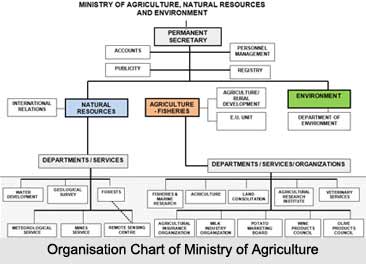 Ministry of Agriculture is responsible for the formulation and administration of the laws and policies relating to agriculture in India. The Ministry comprises of Department of Agriculture & Cooperation, Department of Agricultural Research & Education and Department of Animal Husbandry & Dairying.
Ministry of Agriculture is responsible for the formulation and administration of the laws and policies relating to agriculture in India. The Ministry comprises of Department of Agriculture & Cooperation, Department of Agricultural Research & Education and Department of Animal Husbandry & Dairying.
Organisation of Ministry of Agriculture
The Secretary (A & C) is the administrative head of the Department and Principal Adviser to the Minister on all matters of policy and administration within the Department. He/She is assisted by Additional Secretaries, Agriculture Commissioner, Economic Statistical Advisor, Joint Secretaries, Horticulture Commissioner and Plant Protection Advisor. There is one Technology Mission on Oil Seeds and Pulses (TMOP) & one Commission for Agricultural Cost & Prices (CACP) under the Department. Among the attached offices of the Ministry are the Directorate of Economics & Statistics, Shaslri Bhavan, `ET Wing, New Delhi and the Commission for Agricultural Costs and Prices, Shastri Bhavan, -F Wing, Second Floor, New Delhi; Directorate of Plant Protection, Quarantine and Storage, N.FLIV, Faridabad; Directorate of Marketing & Inspection, N.ILFV, Faridabad (Haryana).
Functions of Ministry of Agriculture
The matters which the Ministry of Agriculture has to deal with are listed below:
The following subjects which fall within List I of the Seventh Schedule to the Constitution of India: Liaison with international Agri-Organisations like Food and Agriculture organisation of the United Nations, handling of CARE goods concerning agriculture, etc; Participation in international conferences, associations and other bodies concerning agriculture and implementation of decisions made thereat; Convention on Locust Control; Plant Quarantine; Industries, the control of which by the Union is declared by Parliament by law to be expedient in Public interest: as far as these relate to:- (a) Development of agricultural industries including machinery, fertilizer and seeds but excluding cotton, ginning and pressing with the limitation that in regard to the development of agricultural industries, including machinery and fertilizer, the functions of the Department of Agriculture and Cooperation do not go further than the formulation of demands and the fixation of targets; (b) Shellac Industry. The Ministry also has to see to the Agricultural Census; Matters relating to damage to crops due to natural calamities; Co-ordination of relief measures necessitated by drought; Matters relating to loss of human life due to drought; Indian People`s Natural Calamity Trust; Technology Mission on Oilseeds and Pulses.
The following subjects which fall within List III of the Seventh Schedule to the Constitution of India (as regards legislation only) are also dealt with by the Ministry: Adulteration of agricultural products other than foodstuffs; Economic Planning (Agricultural Economics and Statistics); Professions (excluding Veterinary Practice); Prevention of the extension from one State to another of Infectious or contagious diseases or pests affecting plants including locusts; Price control of agricultural commodities except foodgrains, sugar, vanaspati, oil seeds, vegetable oils, cakes and fats, jute, cotton and tea; Administration of the Dangerous Machine (Regulation) Act. 1983 (35 of 1983).
For the Union Territories Ministry deals with the subjects mentioned in Parts I and II above, so far as they exist in regard to these territories and, in addition, to the following subjects which fall within List II of the Seventh Schedule to the Constitution of India: Agriculture (Other than agricultural education and research) protection against pests and prevention of plant diseases; Co-operation in agricultural sector, agricultural credit and indebtedness; Genera! Policy relating to the marketing of agricultural produce including pricing, exports etc; Setting up of agricultural markets in rural areas; The Agricultural Produce (Grading and Marking) Act, 1937 (1 of 1937); Insurance (Crop); General Policy in the field of Co-operation and Co-ordination of co-operation activities in all sectors; Matters relating to National Co-operative Organisation; National Co-operative Development Cooperation; Incorporation, regulation and winding up of Co-operative societies with objects not confined to one State; Training of personnel of co-operative departments and co-operative institutions




















